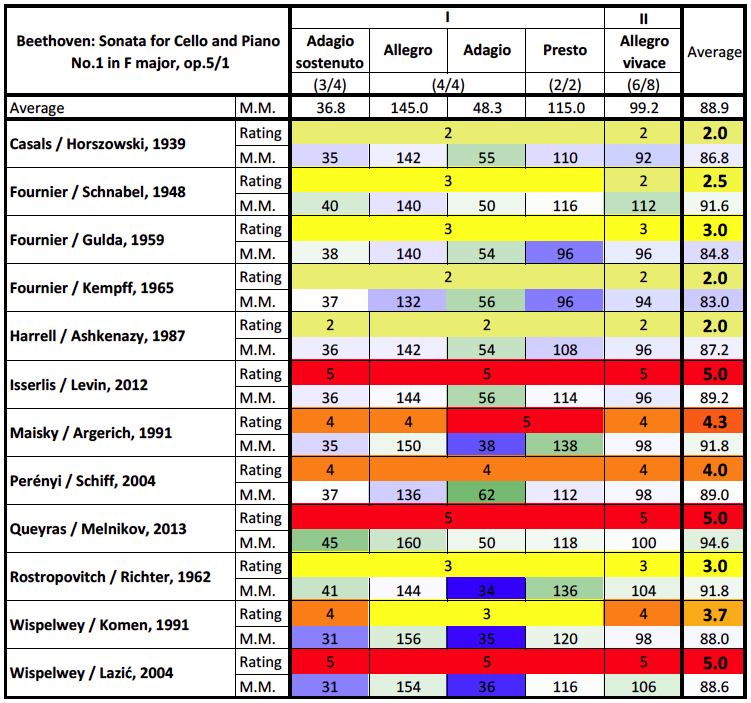Ludwig van Beethoven
Sonata for Piano and Cello in F major, op.5/1
Media Review / Comparison
2016-03-14 — Original posting
2016-10-08 — Brushed up for better readability
Table of Contents
- Introduction
- The Recordings
- Background, About the Composition
- The Interpretations, Overview
- The Interpretations in Detail
- Pablo Casals and Mieczysław Horszowski (1939)
- Pierre Fournier and Artur Schnabel (1948)
- Pierre Fournier and Friedrich Gulda (1959)
- Pierre Fournier and Wilhelm Kempff (1965)
- Lynn Harrell and Vladimir Ashkenazy (1987)
- Steven Isserlis and Robert Levin (2012)
- Mischa Maisky and Martha Argerich (1991)
- Miklós Perényi and András Schiff (2001/2002)
- Jean-Guihen Queyras and Alexander Melnikov (2013)
- Mstislav Rostropovich and Sviatoslav Richter (1962)
- Pieter Wispelwey and Paul Komen (1991)
- Pieter Wispelwey and Dejan Lazić (2004)
- Conclusions
Introduction
This is the first note on the recordings of Beethoven’s sonatas for piano & cello in my music collection, about the Sonata in F major, op.5/1 — references to the CDs are given at the bottom of the respective section, or see the summary on the postings covering Beethoven’s Sonatas for Piano & Cello.
The Recordings
Below you find my comments on the recordings that I have for the Sonata for Piano and Cello in F major, op.5/1 (you find references to the recordings in each of the sections). Here’s a short list of the recordings in this comparison, in alphabetic order (last name of the cellist):
- 1939: Pablo Casals & Mieczyslaw Horszowski
- 1948: Pierre Fournier & Artur Schnabel
- 1959: Pierre Fournier & Friedrich Gulda
- 1965: Pierre Fournier & Wilhelm Kempff
- 1987: Lynn Harrell & Vladimir Ashkenazy
- 2012: Steven Isserlis & Robert Levin
- 1991: Mischa Maisky & Martha Argerich
- 2001/2002: Miklós Perényi & András Schiff
- 2013: Jean-Guihen Queyras & Alexander Melnikov
- 1962: Mstislav Rostropovich & Sviatoslav Richter
- 1991: Pieter Wispelwey & Paul Komen
- 2004: Pieter Wispelwey & Dejan Lazić
Background, About the Composition
Ludwig van Beethoven (1770 – 1827) wrote his Sonata for Piano and Cello in F major, op.5/1 in 1796, while the composer was in Berlin; the sonatas are dedicated to the King of Prussia Friedrich Wilhelm II, but apparently, they were premiered by Beethoven at the piano, with the cello being played by either Jean-Pierre Duport or his brother, Jean-Louis Duport. Allegedly, the sonatas op.5 were the first cello sonatas with fully written-out piano part (as opposed to a basso continuo).
The Movements
Beethoven’s Sonata for Piano and Cello in F major, op.5/1 has just two movements (although in some recordings the first movement is split into two, if not three segments):
I. Adagio sostenuto (3/4) — Allegro (4/4) — Adagio (4/4) — Presto (2/2, alla breve) — Tempo I (4/4)
The movement starts with a slow introduction — often recorded on a separate track, like a movement on its own
The “real” first movement is a sonata movement (with repeat signs around the exposition), annotated Allegro:
The Coda features a short (6-bar) Adagio segment:
This then leads into an extremely virtuosic and fast Presto section
and then ends with a 16-bar Tempo I that brings back the Allegro theme and hence brackets the sonata movement.
II. Rondo: Allegro vivace (6/8)
The second movement is a Rondo with the following theme:
Towards the end, the movement slows down (rallentando) to a short, 2-bar Adagio, which leads into the final, joyful, if not triumphant 8-bar Tempo I endingI
The Interpretations, Overview
In order to provide a rating overview, as well as an idea about tempo relations both within an interpretation, as well as between the two recordings, I have prepared the table below. The color coding for the tempo (blue = slower, green = faster) refers to the average between the recordings:
Note that the metronome rates are approximate. The ratings are relative and don’t take into account the historic value of a recording.
The Interpretations in Detail
All of the recordings below are part of complete sets, covering all Beethoven cello sonatas; most of them also include some or all of the variation sets, two include the sonata op.17, originally written for horn and piano.
Pablo Casals and Mieczysław Horszowski (1939)
Beethoven: The Sonatas for Cello & Piano; Variations WoO 46; Minuet in G, WoO 10/2
Pablo Casals & Mieczysław Horszowski
Otto Schulhof, Alfred Cortot
Allegro / The Great Performers, CDO 4005 (2 CDs, mono); © 2001
Booklet: 4 pp. english

For details / general information on the artists see my posting “Beethoven: Cello Sonata in A major, op.69“. This recording was made in 1939. Here, Pablo Casals (1876 – 1973) plays with Mieczysław Horszowski (1892 – 1993)
I. Adagio sostenuto — Allegro — Adagio — Presto — Tempo I
Duration: 14’10” (exposition not repeated)
Among the traditional recordings, the introduction is slow, static, at least as long as Casals’ cello is not singing its long phrases. Of course, this is to be regarded as (close to) a live recording, which may explain occasional flow issues in the Allegro, and periods where (also Casals’) articulation is slightly superficial, or where the coordination is not perfect.
II. Rondo: Allegro vivace
Duration: 7’33”
Casals’ instrument is singing nicely! However, the tempo is rather slow, lacking both the Allegro character, as well as the vivace aspect. Yet, the coordination between the two artists is often somewhat marginal. The sound focuses on the cello, the piano appears to be oddly located in the background, its sound somewhat muffled.
| Duration: | 21’42” |
| Recommendation: | Primarily a historic document — can’t compete with modern recordings. |
| Rating: | 2.0 (2 / 2) |
Pierre Fournier and Artur Schnabel (1948)
Beethoven: The Sonatas for Cello & Piano; Schubert: 6 Moments Musicaux op.94, D.780
Pierre Fournier & Artur Schnabel
Andromeda, ANDRCD 5108 (2 CDs, mono); ℗ 2007
Booklet: 4 pp. (track listing only)

For details / general information on the artists see my posting “Beethoven: Cello Sonata in A major, op.69“. As in the case of op.69, the sound engineers did some odd things to make this sound like a stereo recording — not really to benefit of the overall experience.
I. Adagio sostenuto — Allegro — Adagio — Presto — Tempo I
Duration: 13’49” (exposition not repeated)
The tempo in the introduction is better than with Casals / Horszowski, less static, better flow. In the Allegro, one can often feel Schnabel pushing the tempo. He clearly appears to be “in the driver seat”!
II. Rondo: Allegro vivace
Duration: 6’22”
In stark contrast to Casals’ recording, this is the fastest of all recordings in this movement: not atypical of a recording with Artur Schnabel! The tempo is so fast that Fournier barely manages his part: while Schnabel clearly has no technical issues, Fournier struggles with the fast passages, is even often superficial.
| Duration: | 20’10” |
| Recommendation: | Primarily a historic document — more that than a real listening pleasure (mostly for the recording sound, less because of the interpretation). |
| Rating: | 2.5 (3 / 2) |
Pierre Fournier and Friedrich Gulda (1959)
Beethoven: The Sonatas for Cello & Piano; Variations WoO 45, 46, op.66
Pierre Fournier & Friedrich Gulda
IDG 00289 477 6266 (2 CDs, stereo); ℗ 1960 / © 2006
Booklet: 24 pp. e/d/f

For details / general information on the artists see my posting “Beethoven: Cello Sonata in A major, op.69“.
I. Adagio sostenuto — Allegro — Adagio — Presto — Tempo I
Duration: 14’48” (exposition not repeated)
Compared to the recording with Schnabel, this not only sounds better (simple stereo, cello on the right, piano in the center), but also features a more even partnership between the two artists, Fournier is given the freedom to form his part, and where Gulda takes the lead, he does so with excellent phrasing, agogics and dynamics: a classic recording, traditional in many ways, but still very good duo playing. Fournier prefers broad, near-legato articulation, many of his staccati are rather portato. In the Presto, Gulda keeps a moderate tempo, allowing for proper / decent articulation.
II. Rondo: Allegro vivace
Duration: 6’54”
Inferior in sound to the recording with Kempff (see below), but a tad faster, and definitely lighter in articulation, and with the superior piano part.
| Duration: | 21’42” |
| Recommendation: | A well-balanced, “classic” interpretation, simple in the stereo setup, but with two artists at the height of their careers. |
| Rating: | 3.0 (3 / 3) |
Pierre Fournier and Wilhelm Kempff (1965)
Beethoven: The Sonatas for Cello & Piano; Variations WoO 45, 46, op.66
Pierre Fournier & Wilhelm Kempff
DG 453 013-2 (2 CDs, stereo); ℗ / © 1966
Booklet: 28 pp. e/d/f/i/sp

For details / general information on the artists see my posting “Beethoven: Cello Sonata in A major, op.69“.
I. Adagio sostenuto — Allegro — Adagio — Presto — Tempo I
Duration: 14’31” (exposition not repeated)
Is Kempff’s articulation in the introduction just soft or often (as I suspect) deliberately arpeggiando? The contours of his playing are rather soft, he avoids strong sf accents. In the Allegro, the interpretation is pleasant, comfortable, but often lacking tension, also Fournier’s playing appears to have lost contours. One of the weakest moments is the start of the development section, which starts oddly slower, tensionless, though it does turn somewhat more dramatic later. Kempff’s playing lacks the brilliance that I’d expect for a piece by the early Beethoven, a hugely successful piano virtuoso at his time.
II. Rondo: Allegro vivace
Duration: 7’08”
Rather coarse playing, not really Allegro (= joyful!), nor very vivace (almost as slow as Casals’ recording): sometimes at the limit of being almost clumsy, especially on the piano.
| Duration: | 21’39” |
| Recommendation: | A conventional recording and interpretation, and not one I would recommend. |
| Rating: | 2.0 (2 / 2) |
Lynn Harrell and Vladimir Ashkenazy (1987)
Beethoven: The Sonatas for Cello & Piano
Lynn Harrell & Vladimir Ashkenazy
Decca / London 417 628-2 (2 CDs, stereo); ℗ / © 1987
Booklet: 39 pp. e/f/d

For details / general information on the artists see my posting “Beethoven: Cello Sonata in A major, op.69“.
I. Adagio sostenuto — Allegro — Adagio — Presto — Tempo I
Duration: 3’05” + 14’49”
Lynn Harrell’s vibrato is rather nervous and omnipresent, it irritates in places where the music is supposed to sound simple, especially in slow sections, such as the introduction. The accompaniment often sounds rather gross, too loud and dominating.
In the Allegro, Ashkenazy often ignores p annotations, playing them f. But his articulation is fairly careful and to the point. In the cello part, I’d prefer less vibrato and more “percussive” (rather than delayed) sf accents instead. On the bright side: they repeat the exposition.
II. Rondo: Allegro vivace
Duration: 7’10”
The cello (actually, the entire interpretation) often (again) sounds rather gross, coarse, heavy, the sound is rather dark and dull.
| Duration: | 25’03” |
| Recommendation: | A conventional recording — hardly one to recommend. |
| Rating: | 2.0 (2 / 2 / 2) |
Steven Isserlis and Robert Levin (2012)
Beethoven: The Sonatas for Cello & Piano, incl. op.17; Variations WoO 45, 46, op.66
Steven Isserlis & Robert Levin
hyperion CDA67981/2 (2 CDs, stereo); ℗ / © 2014
Booklet: 24 pp. e/f/d

This is a recent recording, with Steven Isserlis (*1958), accompanied by Robert Levin (*1947). Isserlis plays a cello by Stradivarius, “Marquis de Corberon”, from 1726, and a Tourte bow; Levin plays a fortepiano by Paul McNulty — a replica after an instrument by Walter & Sohn from around 1805. The recording also includes the three sets of variations (op.66, WoO 45 and 46), as well as the sonata op.17, originally written for horn and piano.
I. Adagio sostenuto — Allegro — Adagio — Presto — Tempo I
Duration: 2’47” + 14’11”
Clearly, the Walter fortepiano is the much, much better choice than a Broadwood. The artists also select a tempo for the introduction that is appropriate for this instrument (i.e., faster than Wispelwey’s). Due to better dampening, the rests may sound even dryer than on the Broadwood. However, right from the first bars, the Walter instrument can expose its excellent, singing sound in the descant, the richness in sound colors!
This continues in the Allegro, where the fortepiano requires much less effort to maintain transparency and clarity. In other words: the articulation appears to be much less of a constant, detailed and meticulous effort to articulate every detail properly. This is not to say that Robert Levin is less detailed and accurate in articulation! The result just appears more natural, and the same it true for clarity and transparency. In addition, the lighter, brighter sound of the fortepiano brings a long a much better sound separation between the two instruments: even when Isserlis plays ff (at any pitch), the fortepiano has no problem, making itself heard. My remarks on the introduction also apply to the Adagio — and I like the natural virtuosity in the subsequent Presto!
II. Rondo: Allegro vivace
Duration: 7’03”
As with Wispelwey/Komen, the tempo is slower than what I expected — but that is more than compensated by the lively sound and articulation on the Walter fortepiano; humor and a joyful atmosphere don’t necessarily require a very fast tempo, but can just as well be achieved through colors, lively articulation.
| Duration: | 24’00” |
| Recommendation: | On a par with the best recordings with a modern grand — with the added benefit of offering a sound that is close to what Beethoven may have heard and must have had in mind: a strong recommendation! |
| Rating: | 5.0 (5 / 5 / 5) |
Mischa Maisky and Martha Argerich (1991)
Beethoven: The Sonatas for Cello & Piano; Variations WoO 45, 46, op.66
Mischa Maisky & Martha Argerich
DG 453 748-2 (2 CDs, stereo); ℗ 1991/93 / © 1997
Booklet: 46 pp. e/d/f

For details / general information on the artists see my posting “Beethoven: Cello Sonata in A major, op.69“.
I. Adagio sostenuto — Allegro — Adagio — Presto — Tempo I
Duration: 3’00” + 12’33” + 1’25”
Measured on most recent “standards”, Mischa Maisky’s vibrato is fairly strong, a little nervous, and ubiquitous — most obvious in the slow introduction. But on the other hand, the two artists manage to maintain the tension, despite a relatively slow tempo; from that point-of-view, this is one of the better inter interpretations & recordings, despite the often metallic tone of the piano.
The Allegro is very vivid, active (too active at times?), fast, dramatic in the first theme, but also allowing for gentle / more intimate tones in the second theme, featuring excellent duo playing and careful articulation; sometimes slightly too fast, with a tendency to push the tempo, to explore the limits of what is technically possible; not all tempo changes are exactly natural (particularly when they need to return to a slower pace). The Adagio is slow, in line with the 4/4 time signature. In contrast, the Presto is extremely virtuosic: the fastest in this comparison, and of course mastered very well. The interpretation is dramatic also in the final, short Tempo I segment, where they accelerated towards the end of the movement.
II. Rondo: Allegro vivace
Duration: 6’38”
Not extremely fast, but vivid, lively playing, very active, with joking accents, humorous agogics, technically excellent, but in the fast semiquaver passages, the cello is sometimes a bit rough.
| Duration: | 23’36” |
| Recommendation: | One of the better, traditional recordings, with excellent moments, sometimes at the limit of being “too active”. |
| Rating: | 4.3 (4 / 4 / 5 / 4) |
Miklós Perényi and András Schiff (2001/2002)
Beethoven: The Sonatas for Cello & Piano, incl. op.17; Variations WoO 45, 46, op.66
Miklós Perényi & András Schiff
ECM New Series 1819/20 (2 CDs, stereo); ℗ / © 2004
Booklet: 28 pp. d/e

For details / general information on the artists see my posting “Beethoven: Cello Sonata in A major, op.69“.
I. Adagio sostenuto — Allegro — Adagio — Presto — Tempo I
Duration: 2’57” + 14’55”
I like Perényi’s limited, harmonic / adaptive vibrato in the slow introduction; excellent duo playing in dynamics and agogics. Schiff articulates very carefully and avoids sounding too gross / loud. The performance features excellent sound balance, is very good in dynamic details (on the border of being overly accurate and to the point in rhythmics and dynamics). The exposition is repeated, even with some subtle variations in the piano part: a good idea, even though not all of the variations are quite to my taste. Mainly in the dramatic part of the development section, the piano does sound a bit strong & dominating (the usual problem with the modern concert grand). In the recapitulation, Schiff is using (some of) the variations from the repeat of the exposition. This may not be to everybody’s taste, but is OK in my opinion.
Interesting: the acceleration towards the Adagio part, which then consequently is played faster than with most others. In fact, I think the Adagio is taken alla breve here (2/2), even though that meter change only is indicated for the subsequent Presto; one can argue that from the notation (groups of four quavers) the Adagio is already (implicitly) alla breve, unlike — interestingly — the Presto itself! The Presto is played well, controlled, accurately, but lacks the “virtuosic touch” of other interpretations.
II. Rondo: Allegro vivace
Duration: 6’55”
Very good, diligent playing, without exaggeration, maybe sometimes a bit too diligent (especially on the piano), to the point where it momentarily starts to lose drive.
| Duration: | 24’45” |
| Recommendation: | Good, solid, excellent playing, maybe lacking some humor & fun? |
| Rating: | 4.0 (4 / 4 / 4) |
Jean-Guihen Queyras and Alexander Melnikov (2013)
Beethoven: The Sonatas for Cello & Piano; Variations WoO 45, 46, op.66
Jean-Guihen Queyras & Alexander Melnikov
Harmonia mundi HMC 902183.84 (2 CDs, stereo); ℗ 2014
Booklet: 20 pp. f/e/d

For details / general information on the artists see my posting “Beethoven: Cello Sonata in A major, op.69“.
I. Adagio sostenuto — Allegro — Adagio — Presto — Tempo I
Duration: 15’45”
As Wispelwey, Queyras is selective with the vibrato (maybe even more selective?). The Introduction is quite different from Wispelwey’s, though: the fastest in the comparison, and the most dramatic, with truly excellent, detailed articulation (on both instruments), excellent sound, and full of tension.
Also the Allegro is the fastest in this comparison, but controlled, with excellent playing. I like the detailed articulation and dynamics. It’s not overly didactic, and devoid of extroverted virtuosity, with excellent sound balance. Melnikov is not shying away from playing strong accents. However, whenever his articulation may appear slightly exaggerated, one can check the score and will find the justification in Beethoven’s writing! Maybe slightly less expressive than Wispelwey / Lazić, but more active and detailed in the articulation.
II. Rondo: Allegro vivace
Duration: 6’44”
Excellent playing, really lively, also with humor (agogics, dynamics and articulation!). At the same time no rough or coarse playing at all, clear, excellent playing throughout (technically clearly better than Perényi/Schiff or Maisky/Argerich), a joy to listen, superb!
| Duration: | 22’28” |
| Recommendation: | Definitely a strong recommendation — and (just like Wispelwey / Lazić) an interpretation that is hard to beat (at least, among recordings using a modern piano)! |
| Rating: | 5.0 (5 / 5) |
Mstislav Rostropovich and Sviatoslav Richter (1962)
Beethoven: The Sonatas for Cello & Piano
Mstislav Rostropovich & Sviatoslav Richter
Philips 412 256-2 (2 CDs, stereo); ℗ 1963
Booklet: 11 pp. e/d/f

For details / general information on the artists see my posting “Beethoven: Cello Sonata in A major, op.69“.
I. Adagio sostenuto — Allegro — Adagio — Presto — Tempo I
Duration: 16’36”
The introduction is static, lacks tension. Only in the last part it picks up some life. In comparison with newer recordings, the Allegro often feels careless, superficial, both in the execution of ornaments, as in agogics, the artists appear to push for speed, which feels like unmotivated acceleration — though it must be conscious, deliberate: for the repetition of the exposition, the artists switch back to the initial, slower tempo for the first theme. Yes, it is virtuosic, but is that enough? The Adagio is slow, static. In contrast, the Presto is extremely fast (only Martha Argerich and Mischa Maisky are faster here!) — purely virtuosic, really.
II. Rondo: Allegro vivace
Duration: 6’43”
A fast, but still more “respectful” tempo than Schnabel’s. Clean, clear and virtuosic playing, with limited humor: mostly rather serious, but nothing to criticize, technically. The rallentando close to the end starts slow already.
| Duration: | 23’19” |
| Recommendation: | Two great artists, and in that sense certainly also a historic document. However, the performance appears to gather age, to get overruled by other, newer recordings. |
| Rating: | 3.0 (3 / 3) |
Pieter Wispelwey and Paul Komen (1991)
Beethoven: The Sonatas for Cello & Piano
Channel Classics CCS3592 (2 CDs, stereo); ℗ / © 1992
Booklet: 20 pp. e/nl/d/f

Pieter Wispelwey (*1962) recorded the Beethoven cello sonatas twice; this is the earlier recording, covering the sonatas only (not the variations or op.17), with Paul Komen playing a historic Broadwood fortepiano from 1823 (the same instrument model that Beethoven received from Broadwood in 1818 as a gift, on behalf of Muzio Clementi). Wispelwey plays a Cello by Barak Norman from 1710.
I. Adagio sostenuto — Allegro — Adagio — Presto — Tempo I
Duration: 3’28” + 14’40”
Even more so than in the Cello Sonata in A major, op.69, the Broadwood is not the ideal choice for this early sonata. In the introduction, it has problems “carrying” the long phrases, “filling the rests”, as it often sounds a bit short and dry. Maybe a slightly faster tempo would have helped? However, it does offer very good sound balance and excellent transparency, fairly good clarity in this recording.
This is confirmed in the Allegro, where the Broadwood often sounds a bit rough (very strong in the bass, especially when octaves are played, occasionally badly defined in the middle, somewhat thin in the upper descant), and the limited effect of the dampers does have its impact here, too. The piano articulation is sometimes a bit “wooden”. Pieter Wispelwey isn’t quite at the level of his more recent recording yet. And also in the Adagio, the piano hardly can carry the tension at this slow tempo (the Presto on the other hand is very good with this instrument).
II. Rondo: Allegro vivace
Duration: 7’04”
Interestingly, this is substantially slower than Wispelwey’s newer recording with Lazić (with a fortepiano, I would normally expect a faster tempo!), but even this way, the Broadwood piano is sometimes at the limit of being noisy.
| Duration: | 25’11” |
| Recommendation: | If you are looking for a HIP recording, rather take the one with Isserlis/Levin above, which I find much better, both in terms of fortepiano and of playing. |
| Rating: | 3.7 (4 / 3 / 4) |
Pieter Wispelwey and Dejan Lazić (2004)
Beethoven: The Sonatas for Cello & Piano; Variations WoO 45, 46, op.66
Pieter Wispelwey and Dejan Lazić
Channel Classics CCS SA 22605 (2 CDs, stereo); ℗ / © 2005
Booklet: 20 pp. e/nl/f/d

For details / general information on the artists see my posting “Beethoven: Cello Sonata in A major, op.69“.
I. Adagio sostenuto — Allegro — Adagio — Presto — Tempo I
Duration: 3’19” + 10’58” (exposition not repeated)
The slowest introduction of all (same tempo as the earlier recording). However, the tempo is OK here, as the artists manage maintaining the tension, through detailed agogics and dynamics — simply excellent! The vibrato is selective (often none at all), the articulation very detailed and careful, but not “ex cathedra”.
In the Allegro and subsequent parts: excellent in transparency, more agogics, more expressive / dramatic, more impulsive that Queyras / Melnikov, excellent Klangrede in the piano. Along with Queyras / Melnikov, this is the best interpretation that I can think of, at least with a modern piano. The Adagio is slow — but again (as the introduction) does not feel that way; the Presto is brilliant, but devoid of “empty, extroverted virtuosity”. The only criticism I have is that sadly, the exposition is not repeated (maybe just to accommodate the variations in the CD set??).
II. Rondo: Allegro vivace
Duration: 7’02”
Compared to Queyras/Melnikov, the humorous aspect is addressed via fresh tempo and lively playing / dynamics, strong agogics / rubato — quite different, indeed, but equally fascinating, marvelous! The Adagio (close to the end) is quite extreme, in strong contrast to the explosive ending!
| Duration: | 21’16” |
| Recommendation: | Definitely a strong recommendation — an interpretation that is hard to beat (at least, among recordings using a modern piano)! |
| Rating: | 5.0 (5 / 5 / 5) |
Conclusions
My findings here are very much in line with the ones for the Sonata No.3, op.69 — see my posting “Beethoven: Cello Sonata in A major, op.69“.
Addendum 1
I’m using pocket scores (Lea Pocket Sores, Kalmus or Eulenburg) to follow this music while listening. —Find pocket score on amazon.com (#ad) —
Addendum 2
Beethoven’s Cello Sonata in F major op.5/1 was featured in a duo recital by Sol Gabetta and Alexei Volodin in the KKL Lucerne on 2016-01-17

































